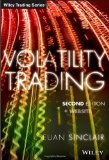This is a book about trading volatility professionally. The target audience is those who already have some familiarity with options theory and are ready to use math in their market analysis. One does not need to be a professional options trader but the book instructs a professional attitude toward trading.
It accomplishes two goals very well. First, it delivers a set of knowledge about volatility markets. Second, it delivers the message that trading is hard and demands deliberate focus. So while the actual material is on the volatility markets, the theme of the book is that one should use all of tools at our disposal, use a systematic methodology and target continuous improvement. In short, if you wish to learn about volatility trading or, in general, how to approach trading of any sort as a business, you will benefit greatly from Volatility Trading. This is not idle talk. I ran an options trading desk and purchased a copy for each person working for me.
Despite having a PhD (yes, despite) and including the relevant math, Sinclair is clear and overwhelmingly practical. Even for those that already trade volatility products, as I do, there is much value in the material. He does much work for us, including:
1) Reading a vast amount of academic and industry research, as well as conducting his own; then highlighting the most valuable nuggets.
2) He puts into clear prose and practical context those most valuable results. For example, the explanation of why leveraged ETF’s erode in value but are not “destined to go to zero” was illustrated nicely with text that complemented the math. Math is necessary and adds to the explanation.
3) He puts the theory into the context of practical reality. Although this is most obvious when he discusses the shortcomings but utility of the Black-Scholes framework, it comes through elsewhere such as under what circumstances higher efficiency estimators fail back into the daily close-close estimator.
That said, there is subject matter relevant to volatility trading that is not covered but still important to volatility trading. For example, volatility options (VIX options) or dealing with portfolios of options. The subjects covered are, for the most part, covered well – the section on behavioral finance is, understandably, given only a quick run through. Even in this section, the practical nature of Sinclair’s outlook shows through as he discusses that we should mind our own foibles for mistakes but also look to those same foibles for sources of potential edge.
From the perspective of trading as a professional, Sinclair bangs the drum on:
1) Quantify what you can.
2) Remember #1, but using non-quantifiable information is valuable and, often, necessary.
3) Understanding that trading, particularly options trading that is so path dependent, is about playing the probabilities. Keep the long run in mind.
4) Trading requires having an edge; to best exploit it, understand it and the tools you use.
5) Emphasize the practical, particularly developing a process.
I cannot provide a review of the web site as I have not yet used it.
I will conclude with Sinclair’s own words: “Successful trading is about developing a consistent process.” Knowledge is essential but insufficient. I think that is what Euan Sinclair would hope the reader came away with and kept. Everything else can be researched – and much of it can be found in “Volatility Trading.” I find it very valuable and highly recommend it.
If you enter Amazon through my site (the image above), I will get a small commission. I am experimenting with this as a source of revenue for my blog. Hopefully reviewing the book (and my other posts) added some value. If so, great. Incidentally, the commission is already built into Amazon prices and the price stays the same whether you enter from my site or not.

